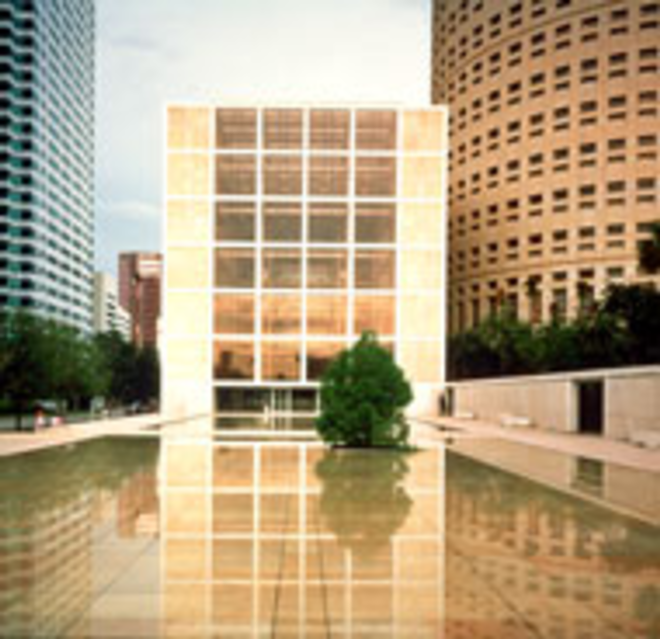When I last wrote about the city's plans to demolish the Dan Kiley garden at the corner of Ashley Drive and Kennedy Boulevard, I felt it as a personal and civic loss. Several people told me they felt the same way.
Since then, I've learned the garden is considered so important by cultural landscape experts that its destruction would also be a significant loss to the nation, not to mention a black eye to the reputation of Tampa and the Tampa Museum of Art for failing to preserve it.
In fact, The Cultural Landscape Foundation in Washington, D.C., mounted a national drive to save the garden after reading our column about the city's plans to destroy it. (See "Secret Garden" March 5-11, http://www.weeklyplanet.com/ 2003-03-05/metropolis.html.)
"There are over 90,000 landmarks on the National Register [of Historic Places]," says Charles Birnbaum, founder of the Cultural Landscape Foundation and coordinator of the National Park Service Historic Landscape Initiative. "Only 1,840 derive their significance from landscape architecture. ... So you have this very elite group, and Dan Kiley is the only living landscape architect to be a part of that group."
Birnbaum created the Foundation in 1998 while on sabbatical from the Park Service for a Loeb Fellowship at Harvard University, and has conceived and edited two books on landscape architecture. He has worked with groups across the country and around the world to preserve cultural landscapes by famous architects and unknown gardeners working the local vernacular.
The Tampa garden is a significant part of Kiley's canon of work, says Birnbaum, because it defined a decade of landscape architecture (the 1980s), and because of its unique interaction with the NationsBank building designed by Harry Wolf (more about that next week). The project received an honor award in 1985, before it was even built, from the American Institute of Architects for the innovative way the building and garden work together and relate to the surrounding environment.
Birnbaum visited the garden this month when he was in Florida speaking to an historic preservation group in Bradenton and was appalled at its condition, even though he has seen it happen before. "Municipal governments will allow things to fall into disrepair. A place becomes dark and ominous and people want to see change because they don't want to go there."
Because Kiley's design is so abstract, he says, people don't understand it, and they don't know what they have. "The museum should be the progenitor of that [understanding]. They should hold the city accountable for maintaining it."
Chicago landscape architect Peter Schaudt, who worked on the garden's design with Kiley, also visited the garden this month and wrote the piece posted on the Foundation's website. In it he writes: "It is ironic to think that the primary purpose of The Tampa Museum of Art as noted on their website is to 'collect, preserve, display and interpret works of art reflecting art forms of regional, national and international importance for the public on a regularly scheduled basis.' Right under their nose is an important masterwork by the most celebrated landscape architect in post-war America that fits their collection's management purpose, and yet its very future is threatened with demolition."
He goes on to say that the lack of maintenance has rendered the park unsafe and unsightly: "The plaza now resembles a modern ruin, almost 'cemetery' like. Astonishingly, the project is only 15 years old."
The good news, he says, is that the garden can be restored.
But first it must be protected from the wrecking ball.
It's remarkable that we even have a Kiley garden and preposterous to think we might lose it to ignorance and carelessness.
The ray of hope is that it's a whole new ballgame in this city. Our new mayor and city council chair understand and appreciate the cultural landscape in a way previous administrations have not. I encourage you to let them and me know how you feel about the Kiley garden.
There are also a lot of intelligent and caring people on the museum board who would be appalled if they knew the significance of what is being done in their name. Among them is Joan Jennewein, a longtime historic preservationist. Officers are James Pappas, Sara Richter, Franci Rudolph, Stephen Dickey, Gwendolyn Stephenson and Jeffrey Tucker.
Cultural landscapes are important, says the Foundation's website, because they give us a sense of place, they're a part of our national heritage and of our lives, and they reveal our relationship with the land over time. Over the past three decades, people have come to understand the historic preservation movement for architecture, too late to save some of the nation's most precious buildings, but in time to save others. The move to preserve landscape architecture is somewhat newer, even though the National Historic Preservation Act of 1966 does include landscape architecture, and is just beginning to take hold across the nation and around the world. It's a burgeoning topic throughout the country right now.
To let the city and the museum know how you feel about the Kiley garden, call, write or e-mail them (and send me a copy):
Pam Iorio, Mayor, City of Tampa, 306 E. Jackson St., Tampa, FL 33602; 813-274-8251 or [email protected].
Linda Saul-Sena, Chair of Tampa City Council, City of Tampa, 306 E. Jackson St., Tampa, FL 33602; 813-274-8131 or [email protected].
Emily Kass, Director, Tampa Museum of Art, 601 N. Ashley Drive, Tampa, FL 33605, 813-274-8130 or [email protected].
Senior Editor Susan F. Edwards can be reached at [email protected] or 813-248-8888 ext. 122.


